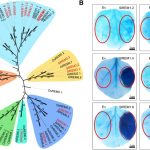Roots, Bacteria, Ethylene, and Rhizosheath Formation
The rhizosheath, the sticky part of the rhizosphere, is the layer of soil that adheres to roots upon excavation of the root system. The stickiness  of the layer arises from mucilage and other substances secreted by roots, soil microbes or both. Rhizosheaths preferentially form in drier soil and are thought primarily to improve plant drought resistance. Rhizosheaths, however, also increase resistance to many other abiotic stresses, including the stresses associated with soil strength, soil acidity, and nutrient deficiencies such as reduced phosphorus, nitrogen, and zinc. Zhang et al. (10.1104/pp.19.01020) have found that rice (Oryza sativa) roots form a pronounced rhizosheath under conditions of moderate soil drying, but not under continuous flooding regimens. This is of especial interest because rice cultivation requires enormous quantities of irrigation water: in fact, the majority of irrigation water use in Asia is committed to rice cultivation. In their efforts to understand how plants and microbes interact in the rhizosheath, the authors have found that plant growth-promoting rhizobacteria of the Enterobacteriaceae are enriched in rhizosheaths. Interestingly, the ethylene pathway was found to be induced in the rhizosheath-root system under conditions of moderate soil drying. Enterobacter aerogenes, a bacterium isolated from the rhizosheath, degrades the ethylene precursor 1-aminocyclopropane-1-carboxylate, thereby increasing rhizosheath formation: a mutant strain lacking this ability failed to enhance rice rhizosheath formation in response to soil drying. These results suggest that root-bacteria associations substantially contribute to rhizosheath formation in rice under moderate soil drying conditions by mechanisms that involve ethylene. This research suggests new strategies to reduce water consumption in rice production, one of the most water-intensive human activities.
of the layer arises from mucilage and other substances secreted by roots, soil microbes or both. Rhizosheaths preferentially form in drier soil and are thought primarily to improve plant drought resistance. Rhizosheaths, however, also increase resistance to many other abiotic stresses, including the stresses associated with soil strength, soil acidity, and nutrient deficiencies such as reduced phosphorus, nitrogen, and zinc. Zhang et al. (10.1104/pp.19.01020) have found that rice (Oryza sativa) roots form a pronounced rhizosheath under conditions of moderate soil drying, but not under continuous flooding regimens. This is of especial interest because rice cultivation requires enormous quantities of irrigation water: in fact, the majority of irrigation water use in Asia is committed to rice cultivation. In their efforts to understand how plants and microbes interact in the rhizosheath, the authors have found that plant growth-promoting rhizobacteria of the Enterobacteriaceae are enriched in rhizosheaths. Interestingly, the ethylene pathway was found to be induced in the rhizosheath-root system under conditions of moderate soil drying. Enterobacter aerogenes, a bacterium isolated from the rhizosheath, degrades the ethylene precursor 1-aminocyclopropane-1-carboxylate, thereby increasing rhizosheath formation: a mutant strain lacking this ability failed to enhance rice rhizosheath formation in response to soil drying. These results suggest that root-bacteria associations substantially contribute to rhizosheath formation in rice under moderate soil drying conditions by mechanisms that involve ethylene. This research suggests new strategies to reduce water consumption in rice production, one of the most water-intensive human activities.



